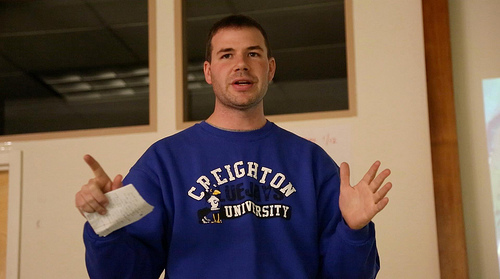Remember Guantánamo — the ugly poster-child of the post 9/11 American extrajudicial detention system? Along with Abu Ghraib, it was the most in-your-face example of the terrible, absolutely inhumane pit-of-revenge this country would stoop to during its War on Terror. If not for the more than 100 prisoners currently on hunger strike and in the headlines, Guantánamo might actually seem like a distant memory. After all, for his first act as president in 2009, Barack Obama signed an executive order to close the detention facility. It was a symbolic, yet decisive end to an era. Except it wasn’t. That era continued, under new leadership, and with new weaponry. And the prison stayed open.
While most Americans have learned to forget, or simply give up on the Guantánamo chapter ever ending, a small band of activists have kept the issue alive. Known for donning orange jumpsuits and black hoods, and parading around the nation’s capital, these activists are the only form of domestic resistance continually raising this issue. But why do they do it? Why, when there are so many other injustices to confront — injustices that involve more than 166 people on some distant strip of land in Cuba?

These are questions that I put to my first guest on We Are Many, the new podcast by Waging Nonviolence. His name is Luke Hansen and he’s an active member of Witness Against Torture — the campaign to shut down Guantánamo. Over the past several years, Luke has managed to meet former detainees exiled in Bermuda, as well as travel to Guantánamo itself as a journalist for the weekly Catholic magazine America. If anyone can explain why this issue is of utmost importance, it’s Luke.
But beyond making sense of the Guantánamo issue, this episode, and the ones to come, will examine what it is that makes an activist. Because, after all, no activist was born caring about an issue. There’s always some reason or event that guides them. And once you realize that, you realize that anybody can be an activist. It’s just a matter of circumstance. But once you do become an activist — and maybe this is why non-activists have a hard time relating — the work changes you. It provides a new outlook. And that kind of transformation is the key ingredient to any good story.
So, with that explanation, I present the first episode of We Are Many. Listen. Learn. Enjoy. And remember Guantánamo.

Bring on the WNV multimedia empire!
GREAT REPORT. THANK YOU.
Hey just wanted to give you a quick heads up. The text in your article seem to be running off the screen in Opera.
I’m not sure if this is a format issue or something to do with browser compatibility but I figured
I’d post to let you know. The design and style look great though!
Hope you get the issue fixed soon. Many thanks